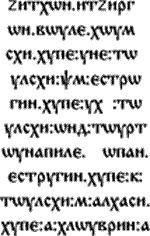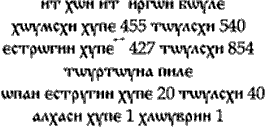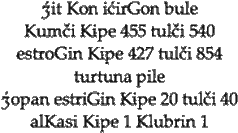Back
In Russian
Hunnic Writing
Turanian Writing
Paleography of 8 Türkic Alphabets
Scripts Adopted by Türkic Peoples
Zelenchuk Inscription
Avar Dateline
Besenyo Dateline
Bulgar Dateline
Huns Dateline
Kimak Dateline
Kipchak Dateline
Kyrgyz Dateline
Sabir Dateline
Bulgarian Inscription in Greek Script
Introduction
Professor Mudrak O.A. in his work Notes on language and culture of Danube Bulgars provides analysis of an undated Bulgarian language inscription in Greek script. The following summary preserves the substance of the analysis, for the omitted detailed refer to the article (in Russian) in the links. The bottom line is that, despite of the various claims to the opposite notwithstanding, this longest survived inscription is freely and meaningfully read in a plain Türkic language. A great help in reading was the use in the original of the colon (:) standard Türkic word separator. In spite of the partial selection for the comparisons, which excluded the closest descendants of the Early Middle Age Bulgars, the Itil Tatars and Balkars, the facts refute the spin given in the article, illustrating that the inscription was written in the near-standard Kipchak language instead of being compliant with the official Chuvashian doctrine.
The summary below uses a common Russian alphabet font to render the Greek letters of the original, which is a close duplicate of the Greek alphabet, and only needs to be complemented by a single additional Greek letter "ώ". Ironically, more difference lay between the Soviet/Russian-militated quasi-Cyrillic Türkic alphabets than between the Russian and Greek, which demonstrates a superior linguistic mastery of the system, able to divide a single common Arabic alphabet into a dozen of mutually incomprehensible alphabets. A set of three periods, ..., indicate a skipped text of the original, for the details refer to the original. The text of the summary attempts to minimize problems in displaying oddball fonts, replacing where possible the author's diatritics with English "ch's" and "sh's". While the difference between a, ấ, ẩ, ǽ, and ə is important in describing the modern languages, in producing prothesises for 1000-year old languages, where even the phonetics behind "k's", "g's", "x's", and "q's" is sometimes conjectural, the confidence in a capability to discern the phonetics of, say, "a" as "a" or "ə" is quite thin, and so are the conclusions based on these propositions.
|
Links |
||||||||||||||||||||||||||||||||||||||||||||||||||||||||||||||||||||||||||||||||||||||||||||||||||||||||||||||||||||||||||||||||||||||||
|
http://starling.rinet.ru/Texts/bulgar.pdf
|
||||||||||||||||||||||||||||||||||||||||||||||||||||||||||||||||||||||||||||||||||||||||||||||||||||||||||||||||||||||||||||||||||||||||
Prof. Mudrak O.A.
|
||||||||||||||||||||||||||||||||||||||||||||||||||||||||||||||||||||||||||||||||||||||||||||||||||||||||||||||||||||||||||||||||||||||||
|
The purpose of this work was study of Bulgarian written monuments written by known scripts. The questions of isolated lexical loans are not examined. PRESlav'S INSCRIPTION In 1946. I.Venediktov published a Bulgarian inscription found in one of the churches near the city of PreSlav. The inscription is in Greek script (Fig.1):
Independently from each other, this inscription was studied by J.Denis and Fr. Altheim. According to their readings the inscription represents an inventory of arms or chain armored warriors commanded by two superiors.
Both translations elicit great doubts in the philological interpretation of the monument, because they do not consider the script system, and translate the lexicon too loose, and in particular, connect the whole text with a listing of the arms, which is rather doubtful by any Türkic standards. The analysis of the monument shows, that between the colons are the numerals, or in other cases are the Bulgarian words. And because of repetitions, the structure of the text is clearly visible, and it can be divided into sentences or syntaxically visible expressions (Fig.2). The following should be said about the graphic system: 1. The script does not use the letter "kappa" κ, but only "hi" χ (Shown as "kh" in the transliteration below). 2. The script does not use the letter letters ι (only è) and î (only ώ) for the vowels. Later, similarly, in Cyrillics was used only the sign for "eta" and to render [i]. Though in the Bulgarian inscription is used only "omega", phonetically it is used on as "î micron" î, and is rendered in ligature ώó [u], whichto the corresponds Greek and Slavic î. The vowel ó at at that time, probably, still differed from ι, è, compare the alternation inside the same word åñòðώãèí and åñòðóãèí. In transliteration it is rendered via [i]. 3. The sonorous affricative [3] is rendered in the monument by "dzeta", and the voiceless [ts] is rendered by ligature τz. The sequence ñõ is obviously a ligature, because it is found in the text only after consonants, and the sequence of three consonants in Türkic languages are restricted. As a comparison with the Chuvash show, that way is rendered the sibilant of the affrikate [ch]. This is a rather unusual way of rendering of the affrikate, but however it is possible that that is a simplification of a trigram combination τñχ. zit khon ićirgon
bule A new (Prof. O.A.Mudrak) translation of the inscription: seven days working
hard (=becoming assiduous); Translation Dictionary: zit khon - "seven days", zit is Türk. *jeti. khon - Chuv. kon "day" (Türk. *kün). The Chuvash and Bulgarian forms reflect *ö (Mudrak 1993, p. 69). (Here and below the Prof. O.A.Mudrak is bending facts to get a proper evidence conforming to the official doctrine. It maybe a self-censorship that, in addition to the official censorship, existed in the 20th century and is still with us: missing examples are Hypothetical Original Root gün, present Turkmen gün, Cuvash kun, Gagauz gün, Turkish, Azeri gün, Karachai, Kumyk kün, Tatar kö, Kazakh kün, Uzbek, Uygur kun, Tuvinian xün, Sakha kün, Khakassian kün, Kirghiz kün, see Download dictionary of 1819 words in 13 Türkic languages - Excel file - Translator's Note) ićirgon - "working hard". This word is a derivative from pra-Türk. *ilch "task, work" (Chuv. əś, Türk. *ish). In this case it is visible that in the Bulgarian by that time pra-Türk. combination *1ñh was simplified (like in modern Chuvash), even though in so called "Bulgarisms" in the Hungarian language they are still retained: compare Hung. gyümölcs "fruit" ~ Chuv. śiməś ~ Türk. *jemish < pra-Türk. *jemilch (see. Illich-Svitych 1971, p. XV). (Reality/spin check: Turkmen iš, Cuvash eç, Gagauz iš, Turkish, Azeri iš, Karachai, Kumyk iš, Tatar eš, Kazakh is, South Alaic iš, Uzbek, Uygur iš, Tuvinian iš, Yakut i:s, Khakassian istenie, Kirghiz iš. If you give only white balls to the academicians to vote, there will be no black balls in the voting urn, and viola! a new academician is born! Welcome to our science shop where we make science! - Translator's Note) bule - 1) "together" ~ Chuv. -bala, Türk. -bi/üle (n). In this case in the inscription the sonorous consonant in anlaut as a result of sandhi after previous nosal sonant; 2) a "connecting" verbal adverb from a Türk. verb *bol- "to become" (Chuv. pol-) or Türk. *böl- "divide" (Chuv. pül-) (I.e. this is a euphemism for simple " Not Chuvash " in Russian Türkological parlance. All you need is to learn how to read the blanks between the black lines - Translator's Note). khumchi - "a type of a cup" (?) pra-Türk. *kawm(i)ch > Tuv. ximish, Uig. qemich. Judging by the Tuv., in this word was pra-Türkic.... A Chuvash correspondence to this word is not known yet, but however in quite a lot of nominal roots in the Chuvash were preserved the final vowels that were lost in other subgroups... (I.e. another high level euphemism for " Not Chuvash " in perfectly elucidated mumbling - Translator's Note). kiðå - " a kind, a form "... tulchi "sated, achieve, increase" ~ Chuv. tol-, Türk. *töl-. Here the form of the 3rd person past perfect -ñhi ~ Chuv.-ñhə, Türk. *-di/i with palatalized dental ñh before *i / ι. estrogin, estrigin "earring, clothes pin" ~ Türk. *isirga. (Here an inquisitive reader will be served better by going through the original, and also through the Vasme'r Dictionary, to enjoy an amazing legwork of authoritative scholars: the Assyrians, and the Türks from Danube to Pacific managed to borrow the word "isirga" from Slavic. Not even a fluff of idea visits the immenents that this is a Hunnic or pre-Hunnic borrowing into Slavic that created the Slavs proper, as a splinter of Balto-Slavs, by inclusion a part of the Balto-Slavs into the Türkic orbit. Without borrowings like "isirga" there is no Slavs, they are still undifferentiated Balto-Slavs. Based on a property of an isogloss, and a timing of Bulgar-Slavic contacts, the author can date the time of acquisition of this word by the poor Ancient Assyrians: 7th-9th c. AD. Never underestimate the magical powers of the linguistic sciences on the way from A to Z! - Translator's Note). turtuna - a connecting verbal adverb from the verb "drug on, extend (task), bargain" ~ Chuv. turdn-, pra-Türk. *tawrt-un- > Tuv. tirtin- (Mudrak 1993, p. 104). By the beginning of the Middle Chuvashian period in the development of the Chuvashian phonetics (approximately at the boundary of the 1-st millennium) in the place of the pra-Türk. *aw was already -û-(Mudrak 1993, p. 132), and the Bulgarian in this case and also in the word kumchi, very well corresponds with the Middle Chuvashian reflexes of the pra-Türk. *-aw-. pile - connecting verbal adverb from the verb "know, be able, can" ~ Chuv. pə1-, Türk. *bil-. (A slight slight of hands again: Turkmen bil, Cuvash pĕl, Gagauz bil, Turkish, Azeri bil, Karachai, Kumyk bil, Tatar belü, Kazakh bilu, South Alaic pül, Uzbek, Uygur bil, Tuvinian bilir, Yakut bil, Khakassian pilerge, Kirghiz bilüü - Translator's Note). zopan "caftan" ~ a word spread in the Balkans, noted in Slavic as *zupan, Greek ζγπαí, Ital. giuppane. (M.Kashgari: čuðàn " - assistant to vollage elder", this is another ridiculous example of Slavic "export" to both the Türks from Danube to Mongolia, and to Latins in Italy - Translator's Note) alkhasi "pendant earring" with a possessive affix of 3rd person, ~ Chuv. alga id. < pra-Türk. *elke; ~ Chuv.-je, Türk. *-si / ι, which points to orthographic indiffirence in this monument between "sh" and "s", but judging by the development of the vowels, here should be a final palatalized "s" (see below). khlubrin (possibly with archaic instrumentalis in formation of adverbs) ~ Chuv. lüprən, lüppərən "languid, lazy" (not completely clear the initial kh- in Bulgarian; may be it is a prothetic h-before an initial fluid sonant?). Elucidation: This inscription is obviously a record or a study note reflecting a purchase or production of small metal products. Its author was either a trader, or a smith (jeweller?). In the first case "turtuna" should be translated as "bargaining", and in the second as "drugging on the task, delaying".
Resume: Judging by consistency, the Bulgarian language is the most closely related to the Chuvash language, and it has characteristical only for Chuvash language unique developments of the phonemes ¹ 1, 2, 5, 8 (the lexical alternate *ü ~ *ö in a word "day"), 10, 15, 17-20..... (See the continuation of the Bulgaro-Chuvash panegyric in the original. In reality, the only hard conclusion that can be made is that the Bulgars used Türkic for routine notes. The presence of palatalized dialect is inconclusive, but should not be surprising to be somewhat present, since the Suvars, a titular member of the Mari-Suvar conglomerate now called Chuvash, were a prominent component of the Bulgar societies - Translator's Note) Despite the limited material, it is possible to note that the spelling norms of recording the Bulgarian language with the Greek letters are fairly well developed, and form a harmonious perceptible system, compare the use of ligatures ώó, ñõ and regular exclusion of letters ê, î, ι. This allows to presume a presence of a (short-lived?) tradition of use by the Bulgars (by that time partly Christianized) of the Greek script for their household needs. Hopefully, new finds of Bulgarian inscriptions with the Greek letters would come to light. |
||||||||||||||||||||||||||||||||||||||||||||||||||||||||||||||||||||||||||||||||||||||||||||||||||||||||||||||||||||||||||||||||||||||||
|
Home Back In Russian |
Besenyos, Ogur and Oguz Hunnic Writing Turanian Writing Paleography of 8 Türkic Alphabets |
Codex of Inscriptions - Index Scripts Adopted by Türkic Peoples Zelenchuk Inscription |
Alan Dateline Avar Dateline Besenyo Dateline Bulgar Dateline Huns Dateline |
Karluk Dateline Kimak Dateline Kipchak Dateline Kyrgyz Dateline Sabir Dateline |
||||||||||||||||||||||||||||||||||||||||||||||||||||||||||||||||||||||||||||||||||||||||||||||||||||||||||||||||||||||||||||||||||||
9/29/05


